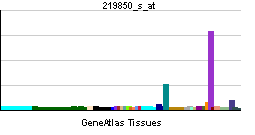EHF (gene)
| Ets homologous factor | |||||||||||
|---|---|---|---|---|---|---|---|---|---|---|---|
| Identifiers | |||||||||||
| Symbols | EHF ; ESE3; ESEJ | ||||||||||
| External IDs | Template:OMIM5 Template:MGI HomoloGene: 7301 | ||||||||||
| |||||||||||
| RNA expression pattern | |||||||||||
 | |||||||||||
| More reference expression data | |||||||||||
| Orthologs | |||||||||||
| Template:GNF Ortholog box | |||||||||||
| Species | Human | Mouse | |||||||||
| Entrez | n/a | n/a | |||||||||
| Ensembl | n/a | n/a | |||||||||
| UniProt | n/a | n/a | |||||||||
| RefSeq (mRNA) | n/a | n/a | |||||||||
| RefSeq (protein) | n/a | n/a | |||||||||
| Location (UCSC) | n/a | n/a | |||||||||
| PubMed search | n/a | n/a | |||||||||
Ets homologous factor, also known as EHF, is a human gene.[1]
This gene encodes a protein that belongs to an ETS transcription factor subfamily characterized by epithelial-specific expression (ESEs). The encoded protein acts as a transcriptional repressor and may be associated with asthma susceptibility. This protein may be involved in epithelial differentiation and carcinogenesis.[1]
References
Further reading
- Fujikawa M, Katagiri T, Tugores A; et al. (2007). "ESE-3, an Ets family transcription factor, is up-regulated in cellular senescence". Cancer Sci. 98 (9): 1468–75. doi:10.1111/j.1349-7006.2007.00543.x. PMID 17627613.
- Ewing RM, Chu P, Elisma F; et al. (2007). "Large-scale mapping of human protein-protein interactions by mass spectrometry". Mol. Syst. Biol. 3: 89. doi:10.1038/msb4100134. PMID 17353931.
- Park C, Lee I, Kang WK (2007). "Influence of small interfering RNA corresponding to ets homologous factor on senescence-associated modulation of prostate carcinogenesis". Mol. Cancer Ther. 5 (12): 3191–6. doi:10.1158/1535-7163.MCT-06-0570. PMID 17172423.
- Lim JH, Cho JY, Park YB; et al. (2006). "ESE-3 transcription factor is involved in the expression of death receptor (DR)-5 through putative Ets sites". Biochem. Biophys. Res. Commun. 350 (3): 736–41. doi:10.1016/j.bbrc.2006.09.102. PMID 17027647.
- Taylor TD, Noguchi H, Totoki Y; et al. (2006). "Human chromosome 11 DNA sequence and analysis including novel gene identification". Nature. 440 (7083): 497–500. doi:10.1038/nature04632. PMID 16554811.
- Appel S, Bringmann A, Grünebach F; et al. (2006). "Epithelial-specific transcription factor ESE-3 is involved in the development of monocyte-derived DCs". Blood. 107 (8): 3265–70. doi:10.1182/blood-2005-06-2480. PMID 16380452.
- Gerhard DS, Wagner L, Feingold EA; et al. (2004). "The status, quality, and expansion of the NIH full-length cDNA project: the Mammalian Gene Collection (MGC)". Genome Res. 14 (10B): 2121–7. doi:10.1101/gr.2596504. PMID 15489334.
- Strausberg RL, Feingold EA, Grouse LH; et al. (2003). "Generation and initial analysis of more than 15,000 full-length human and mouse cDNA sequences". Proc. Natl. Acad. Sci. U.S.A. 99 (26): 16899–903. doi:10.1073/pnas.242603899. PMID 12477932.
- Silverman ES, Baron RM, Palmer LJ; et al. (2003). "Constitutive and cytokine-induced expression of the ETS transcription factor ESE-3 in the lung". Am. J. Respir. Cell Mol. Biol. 27 (6): 697–704. PMID 12444029.
- Tugores A, Le J, Sorokina I; et al. (2001). "The epithelium-specific ETS protein EHF/ESE-3 is a context-dependent transcriptional repressor downstream of MAPK signaling cascades". J. Biol. Chem. 276 (23): 20397–406. doi:10.1074/jbc.M010930200. PMID 11259407.
- Dias Neto E, Correa RG, Verjovski-Almeida S; et al. (2000). "Shotgun sequencing of the human transcriptome with ORF expressed sequence tags". Proc. Natl. Acad. Sci. U.S.A. 97 (7): 3491–6. PMID 10737800.
- Kas K, Finger E, Grall F; et al. (2000). "ESE-3, a novel member of an epithelium-specific ets transcription factor subfamily, demonstrates different target gene specificity from ESE-1". J. Biol. Chem. 275 (4): 2986–98. PMID 10644770.
- Kleinbaum LA, Duggan C, Ferreira E; et al. (1999). "Human chromosomal localization, tissue/tumor expression, and regulatory function of the ets family gene EHF". Biochem. Biophys. Res. Commun. 264 (1): 119–26. doi:10.1006/bbrc.1999.1493. PMID 10527851.
- Bonaldo MF, Lennon G, Soares MB (1997). "Normalization and subtraction: two approaches to facilitate gene discovery". Genome Res. 6 (9): 791–806. PMID 8889548.
External links
- EHF+protein,+human at the US National Library of Medicine Medical Subject Headings (MeSH)
| This protein-related article is a stub. You can help Wikipedia by expanding it. |
This article incorporates text from the United States National Library of Medicine, which is in the public domain.